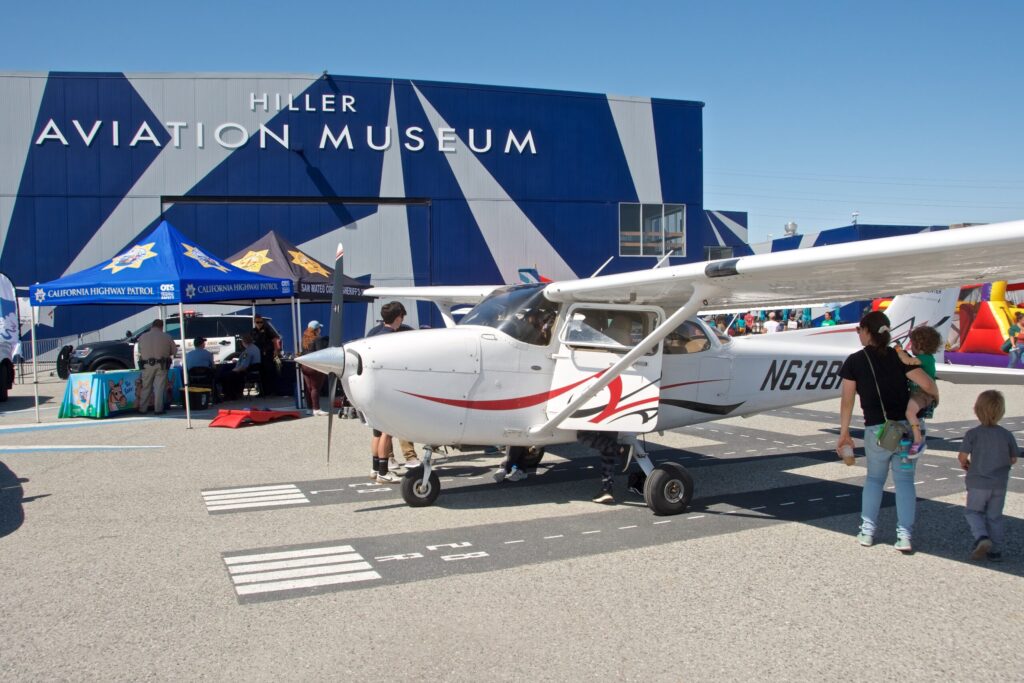Intro:
How did you become interested in aviation?
- I became interested in aviation back in 2016 when I joined the Hiller. I had no prior background/knowledge of aviation. I wanted to learn as much as I could about aviation so I could be successful in my job as museum educator.
How did that lead you to Hiller?
- The Hiller was an excellent place to develop myself personally and professionally. There was and continues to be opportunities to learn and teach kids and their families about the world of aviation. That’s what I like about the Hiller.
What does a typical day look like for you at the museum?
- No work day is the same given that each day has a different set of programs/activities. However, more or less, my day entails actively working with high school students (teen volunteers) and training them on how to work well with the general public. Also, I am involved in supporting and leading public programs such as the museum’s Invention lab and Drone Plex. My typical day is usually a very busy day.
How do you engage visitors in aviation history?
- I engage visitors in aviation history through the museum’s various weekend public programs and permanent exhibits.
Are there any particular exhibits or aircraft at the museum that you love the most? Why?
- I am particularly interested in the Zip Line drone suspended in air. It is located in front of the Drone Plex. It was designed and made here in the Bay Area by Zip Line. The drone was used in Africa to deliver medical supplies to hospitals. I like the drone because it was used to serve people in need.
How does the museum balance history with educating visitors about the future of aviation, including advancements like sustainable flight?
- As a museum, we are aviation history centered, namely, highlighting the past. That said, the museum is also aware of advancements in aviation such as VTOL or vertical take off and flight. In fact, one of our newest exhibits addresses VTOL. This effort is meant to showcase modern day or current happenings in the industry.
Sustainable aviation is becoming a major focus in the industry. What role do you think museums like Hiller can play in promoting sustainability and educating the public?
- The role museums play in this regard would be to make an effort to address the theme of sustainability in aviation via exhibition. After all, when it comes to addressing any theme, in general, museums will showcase those themes in the best way they know how through exhibit making. I would imagine a possible exhibit could address concerns such as environmental impact aviation has and continues to have. Methods to limit or otherwise reduce environmental impact that aviation has.
Have you noticed a shift in visitor interest on this topic?
- I am afraid I have not encountered a visitor who expressed interest in sustainability. Our audience here at the Hiller comprises mainly of small children and their families. As such, this audience is mainly driven by the theme of fun, entertainment and not necessarily sustainability, unfortunately. I would imagine some adult visitors, on the other hand, would have some level of interest in sustainability.
What are some promising technologies or trends in sustainable aviation that you’re particularly interested in?
- I enjoy learning about VTOL, which the museum has an exhibit on. Aircraft that don’t require the use of a runway is of interest to me given they can take off and land without a runway.
How do you think learning aviation history at places like Hiller could play a part in aviation sustainability?
- aviation sustainability is a theme that is developing as we speak.
Are there any exhibits or future plans at the museum that focus on sustainable flight innovations?
- Not sure if the theme of sustainable flight innovations will be addressed in the form on exhibit making. For now, however, the museum’s VTOL exhibit is what we have available for viewing. However, if a possible exhibit that addressed this theme does happen, the focus should be on resolving challenges, improving environmental impact of air transportation, creating conditions for air travel to continue while remaining mindful of possible impact to community and the planet.
Personal Ideas & Future of Sustainable Aviation:
As someone deeply knowledgeable about aviation history, what do you think the future of aviation holds?
- The world the aviation has a bright future, I imagine. Commercial aviation will continue to remain a vital role allowing people and goods to move rapidly, post pandemic. Aviation is vital to global business and uninterrupted service will be key to allowing business to occur on a global scale. I am sensing advances will likely occur in the world of VTOL. Aviation is here to stay.
What do you think are the biggest challenges to achieving sustainable aviation, and how do you believe they can be addressed?
- The biggest challenge in this area is perhaps reducing environmental impact, designing and manufacturing aircraft that are as close to being environmentally friendly as possible.
Closing Questions:
Finally, what advice would you give to young people or students interested in both aviation and environmental sustainability?
- Consider an undergraduate degree in design and engineering, aviation operations. Seek out internships and job opportunities in these particular areas of interest. Consider working for companies that directly make it their business of addressing environmental sustainability as it relates to aviation. Leverage your skills, interest and talents to the benefit of the greater community at large. Keep the preservation of the planet in mind as you conduct your research and development work so as to minimize impact to the environment.
